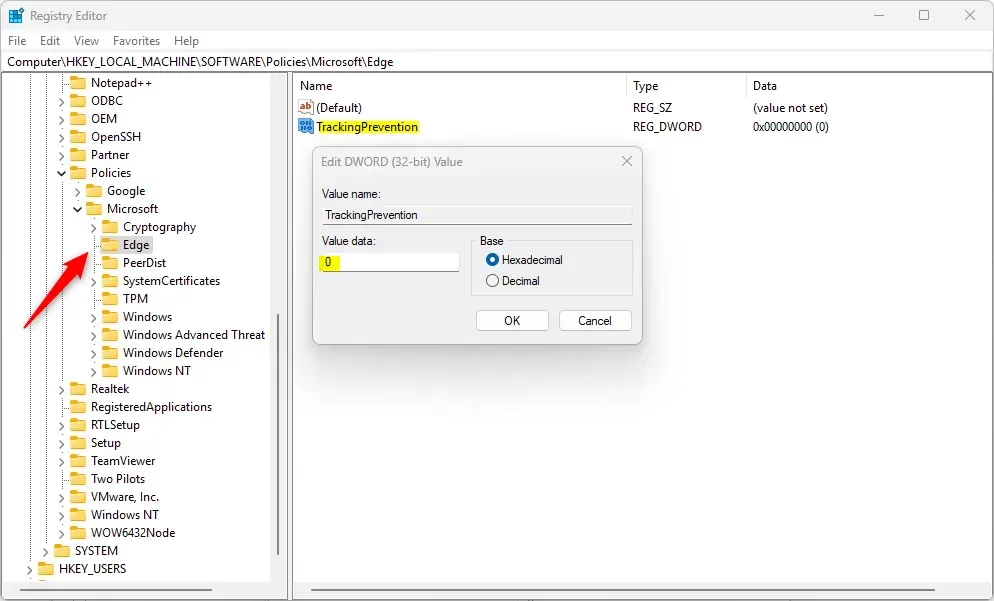This article describes how to enable or disable website tracking in Microsoft Edge, which collects data about your browsing behavior.
Microsoft Edge is the default browser in Windows 11. However, users can switch to their preferred or favorite browser anytime. Edge is based on Chromium, similar to Google Chrome and other Chromium-based browsers today.
Websites you visit online use trackers to gather data about your browsing behavior. These trackers collect information across multiple sites and analyze how you interact with a site, including the content you click on.
When you use Edge, you can detect and block potentially harmful trackers, including cryptomining or fingerprinting.
You can decide what trackers to block using Edge’s “Tracking Prevention” feature.
Enable/Disable Tracking Prevention in Edge
Users can enable or disable the “Tracking prevention” feature in Edge to decide which trackers to block.
Here’s how to do it.
First, open the Microsoft Edge browser.
Then click Settings and more (Alt+F), the 3 horizontal dots button on the top right corner, and select Settings.

Select “Privacy, search, and services” on the Settings page on the left.

Next, select the “Tracking prevention” tile to expand it.

On the “Tracking prevention” settings page, select the “Enable tracking prevention” tile. Then, toggle the button to enable or disable it.
Choose the level of tracking after enabling the feature:
- Basic: Blocks potentially harmful trackers but allows most other trackers and those that personalize content and ads.
- Balanced (Recommended): Blocks potentially harmful trackers and trackers from sites you haven’t visited. Content and ads will likely be less personalized.
- Strict: Blocks potentially harmful trackers and most trackers across sites. Content and ads will likely have minimal personalization.
You can also select “Strict” tracking prevention in InPrivate mode.

You can close the Edge settings page when finished.
Enable or disable Tracking Prevention in Edge via Registry
Another way to enable or disable “Tracking Prevention” in Edge is to use Windows Registry Editor.
First, open the Windows Registry and navigate to the folder key path below.
Remember to back up your registry before making any changes, or create a System Restore point as a precaution.
Computer\HKEY_LOCAL_MACHINE\SOFTWARE\Policies\Microsoft\Edge
Right-click Edge > New > DWORD (32-bit) Value and name the new DWORD TrackingPrevention.
Double-click and open the TrackingPrevention name and set the value using the table below:
1= Force enable Basic tracking prevention.2= Force enable Balanced tracking prevention.3= Force enable Strict tracking prevention.0= Force disable tracking prevention.

Delete the “TrackingPrevention” name created above to restore the default behavior and allow users to enable or disable the feature in Edge’s UI.
TrackingPrevention
You may have to reboot your computer to apply the changes.
That should do it!
Reference:
Conclusion:
In conclusion, Microsoft Edge provides practical tools for managing tracking and enhancing your privacy while browsing. Here are the key takeaways:
- Privacy Control: Users can enable or disable tracking prevention, tailoring their browsing experience to their preferences.
- Tracking Levels: Edge offers three levels of tracking prevention—Basic, Balanced (Recommended), and Strict, allowing users to choose the right balance between personalization and privacy.
- Registry Editing: For advanced users, tracking prevention can also be managed through the Windows Registry, providing an additional method to enforce settings.
- User Empowerment: By utilizing these features, users can better protect their online data and enjoy a more secure browsing environment.
Implementing these settings will enhance your privacy and give you greater control over your online experience.

Leave a Reply Cancel reply